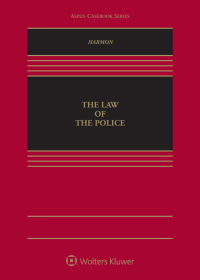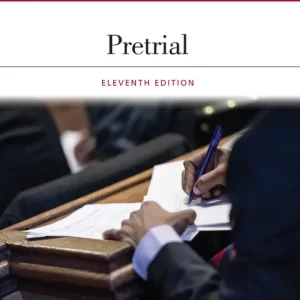Buy The Law of the Police PDF ebook by author Rachel Harmon – published by Aspen Publishers in 2021 and save up to 80% compared to the print version of this textbook. With PDF version of this textbook, not only save you money, you can also highlight, add text, underline add post-it notes, bookmarks to pages, instantly search for the major terms or chapter titles, etc.
You can search our site for other versions of the The Law of the Police PDF ebook. You can also search for others PDF ebooks from publisher Aspen Publishers, as well as from your favorite authors. We have thousands of online textbooks and course materials (mostly in PDF) that you can download immediately after purchase.
Note: e-textBooks do not come with access codes, CDs/DVDs, workbooks, and other supplemental items.
eBook Details:
Full title: The Law of the Police
Edition:
Copyright year: 2021
Publisher: Aspen Publishers
Author: Rachel Harmon
ISBN: 9781454891130, 9781543823301
Format: PDF
Description of The Law of the Police:
This important new book provides materials and analysis for law school classes on policing and the law. It offers a resource for students and others seeking to understand and evaluate how American law governs police interactions with the public. The book provides primary materials, including cases, statutes, and departmental policies, and commentary and questions designed to help readers explore policing practices; the law that governs them; and the law& consequences for the costs, benefits, fairness, and accountability of policing. Among other issues, the notes and questions encourage readers to consider the form and content of the law; how it might change; who is making it; and how the law affects policing. Part I introduces local policing its history, its goals, and its problems; Part II considers the law that regulates criminal investigations; Part III addresses the law that governs street policing; and Part IV looks at policing& legal remedies and reforms. Professors and students will benefit from: Chapters and notes designed to allow flexibility allow professors to assign materials selectively according to the needs of the course. As a result, the casebook can serve as materials for a range of lecture and discussion-based courses on the law regulating police conduct; on legal remedies and reforms for problems in policing; or on more specific topics, such as the use of force or constitutional rules governing police conduct. Descriptions of controversial policing encounters and links to and discussion of videos of such incidents help students practice applying the law, consider its policy implications, and gain awareness of contemporary controversies on policing. Diverse primary materials, including federal and state cases and statutes and police department policies provide a broad exposure to the types of law that govern public policing. Photos, links to videos, protest art, and charts pique student interest, enable richer discussions, and provide additional context for legal materials in the book. Integration of scholarly work on policing, on the law, and on the impact of police practices enables students to make more sophisticated assessments of the law. Notes and questions designed to (a) highlight alternative strategies lawyers might use to change the law, and (b) raise comparative institutional questions about who is best suited to regulate the police. Discussion of legal topics relevant to contemporary discussions of policing studied nowhere else in the law school curriculum.





